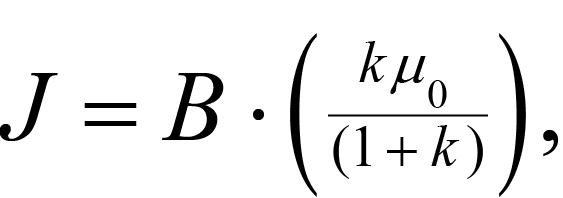Magnetic Susceptibility
Magnetic susceptibility is a measure of the ability of a material to be magnetized. The proportional constant links magnetization to the applied magnetic field intensity (at levels below which saturation and hysteresis are important). Magnetic susceptibility, k, is related to magnetic permeability (m) by:
![]() (1)
(1)
where m0 is the magnetic permeability of free space, which is 4p.10-7. The most magnetically susceptible materials are called ferromagnetic materials which contain iron, nickel, cobalt and many alloys of these materials. Of the several ferromagnetic minerals, magnetite predominates in the applications addressed here. In waste sites, iron and steel are the major sources of magnetic anomalies.
There are several other magnetic quantities, and their relationship is sometimes confusing. The basic magnetic object is the magnetic pole, equivalent to the north end of a magnet. Magnetic poles (a) do not exist as discrete particles, and (b) always appear to come in pairs, and are, therefore, a dipole. A dipole is the result of electric ge in motion; one is made by passing a current I (amperes) around a circuit of area A (meters). Hence, the dipole strength or magnetic dipole moment, M is a vector perpendicular to the plane of that coil with units of ampere-meter2.
All matter consists of charge in motion, but for most materials, the resulting dipoles are randomly aligned and cancel. For certain materials, this cancellation is incomplete, and they become magnetic. Magnetization, J, is the density of aligned dipoles per cubic meter, with units (ampere/m).
The earth's geomagnetic field, B, is the origin of most of the magnetization, J, found in rocks, that is, the magnetization is induced by the present Earth's magnetic field. The relationship is:
 (2)
(2)
The exceptions are materials that have a permanent or remnant magnetization, acquired elsewhere in a strong local magnetic field.
We detect magnetic objects in the subsurface by the way their magnetic fields distort the earth's geomagnetic field. These distortions are termed anomalies. It is generally safe to assume that sediments are non-magnetic. Igneous or metamorphic rocks can have appreciable and locally variable susceptibility.
The magnetic moment M of an object, assuming it is uniformly magnetized, can be estimated as:
![]() (3)
(3)
where V is the volume of the object.
The unit of magnetic susceptibility, k, in the SI system is dimensionless. Magnetic permeability (m) has units of Henrys per meter. The geomagnetic field (B) has units of force per magnetic pole or Teslas. The practical unit of geomagnetism is the nano-Tesla, or gamma.
The pages found under Properties are substantially based on a report produced by the United States Department of Transportation:
Wightman, W. E., Jalinoos, F., Sirles, P., and Hanna, K. (2003). "Application of Geophysical Methods to Highway Related Problems." Federal Highway Administration, Central Federal Lands Highway Division, Lakewood, CO, Publication No. FHWA-IF-04-021, September 2003. http://www.cflhd.gov/resources/agm/![]()
![[logo] US EPA](../gif/logo_epaseal.gif)